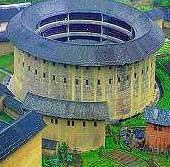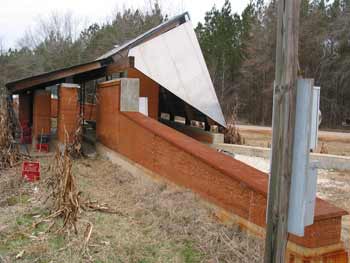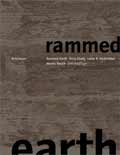A 46,000-square-foot Desert Living Center designed by Lucchesi, Galati Architects of Las Vegas, will use earth-rammed walls that improve heating and cooling, and angled roofing that will collect rainwater for irrigation and flushing toilets.
Adobe That Survives Earthquakes
When an earthquake measuring 8.1 on the Richter Scale rocked the Andean region for over a minute in June, 2001, the southern Peruvian mountain town of Moquegua was literally shaken to pieces. But amid the rubble, three traditional adobe houses were left intact.
Chinese Hakka Architecture

Regarded by architects as the cream of Chinese traditional residential architecture, tulou, or earth buildings, first appeared about 1,200 years ago, and were mostly completed in the Ming (1368-1644) and Qing (1644-1911) dynasties. They were built and inhabited by the Hakka people – a group belonging to the Han family who can trace their ancestors back more than 1,500 years to central and north China. During the hundreds of years of migration, the Hakka people tried to maintain their own culture and way of life, keeping their own unique dialect, custom and cuisine. They built the earth complexes to guard against invasion from local bandits and to protect their children from the influence of local communities. All the families of a Hakka clan lived together in an enclosed rammed earth building.
Earth Building in New Zealand
Graeme North looks at the history and future of earth-building in New Zealand.
Earth Architecture in Scotland
Building with Earth in Scotland by Becky Little and Tom Morton discusses techniques, history, and contains precedents of contemporary architecture.
Rural Studio

The Rural Studio has built several works of rammed-earth architecture including the Mason’s Bend Community Center (above), and the Sanders-Dudley House.
Heikkinen-Komonen
The Kahere Eila Poultry Farming School in Koliagbe, Guinea by Finnish architects Heikkinen-Komonen utilizes wood-frame technology in combination with weight-bearing walls made from a double layer of specially developed, stabilized earth-blocks won the Aga Khan Award for Architecture 2001. More earth projects can be found in their book, Heikkinen + Komonen.
RAMMED EARTH

In Europe, Martin Rauch is regarded as one of the pioneers of modern technical and creative applications for traditional rammed earth construction. His work encompasses residential, hotel, ecclesiastical and industrial buildings, interior design and landscape design in Germany, Britain, Italy, Austria and Switzerland, including projects with Herzog & de Meuron and Schneider + Schumacher. His “Church of Reconciliation” in Berlin was the first load-bearing structure to be built with rammed earth in Germany in the last ninety years. Together with local architects Rauch constructed experimental family homes in Vorarlberg, Austria, and with Kienast Vogt & Partner, he designed a series of garden and park projects. The volume Rammed Earth: Terra Cruda by Martin Rauch and Otto Kapfinger is the definitive introduction to contemporary building with rammed earth.
Taos Fire

In the milleniua of occupation of the Taos Pueblo, this is likely not the first time that Pueblo residents sat atop their earthen structures to watch the forest burn.
Ronald Reagan

Rancho del Cielo, the former Western White House of the former president Ronald Reagan, where he spent more than a full year of his eight years in office, was first named Rancho de los Picos after Spanish settler Jose Jesus Pico, the last Mexican Governor of Alta California, who moved north from Mexico and built the original adobe house in 1871. The Pico family owned the property until 1941, when it was sold to Frank Flournoy for $6,000, who named the property Tip Top Ranch. In 1955, Roy and Rosalie Cornelius bought the ranch and purchased additional land to add to the property. The Reagans bought the 680-acre ranch in 1974 for $527,000, when Reagan’s second term as governor of California was coming to an end. The Young America’s Foundation bought the Ranch in 1998 to preserve it as an historical site.
